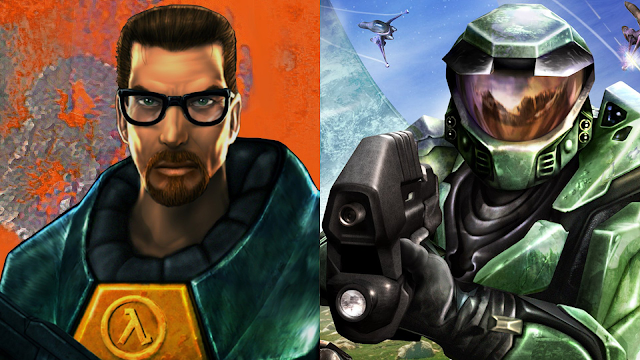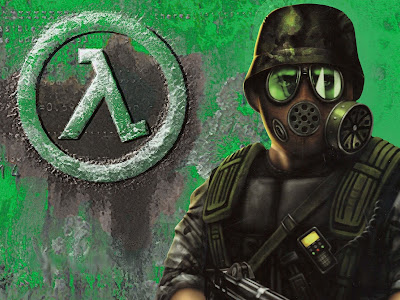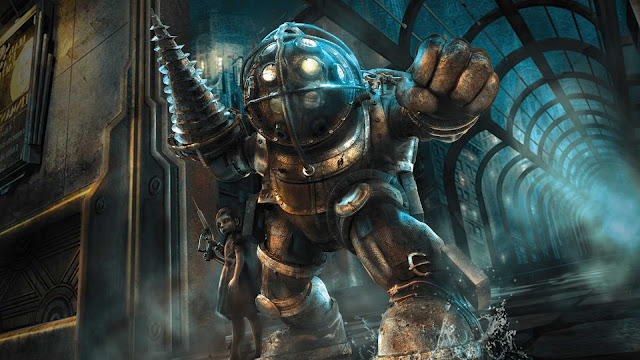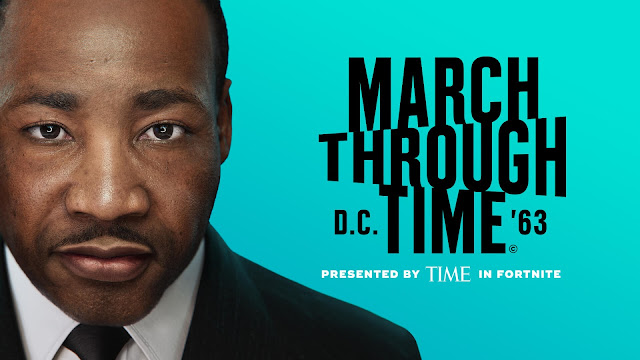Half-Life, Halo, and the Art of the Side Story
I recently beat the original Half-Life and it's expansions after years of putting it off; fairly fun game though anytime you have to go to Xen it sucks my soul out. But that's not really what i want to talk about, if I straight up reviewed Half-Life I wouldn't have much to say that others haven't; basically, "Great but aged, stop at Xen." What interested me however was how Half-Life and it's expansions nail the art of the side story in a way that I've only really seen once; with the original Halo on Xbox and it's book adaptation.
Both Half-Life and Halo have fascinating tales in their own way but both also leave room to see various sides of the same conflict. Its an odd similarity, but I think it's worth exploring the kinds of stories they tell. Who knows, maybe it might inspire others to try something similar.
Half-Life follows Gordon Freeman, an MIT graduate working in the massive underground Black Mesa Research Complex. When a teleporter experiment goes awry it's up to Gordon to survive the alien hordes spilling into the complex, find a way to end the invasion, and outwit the military sent to kill everyone at Black Mesa.
What makes Half-Life's story rife for expansion is that while you're told that others are working to stop the alien invasion you only see Gordon's actions. That's not a criticism, the unbroken narrative told entirely through the eyes of one man is what made Half-Life revolutionary in 1998. Though it would be really neat to see the perspective of say a fellow scientist or even a marine sent to wipe out the Black Mesa faculty.
Luckily Valve saw the same thing and with Gearbox put out three expansions to Half Life, Opposing Force, Blue Shift, and Decay. Of the three Opposing Force is the best, following the story of one of the members of the military force sent to wipe out Black Mesa and put down the alien threat. Of course things aren't as straight forward as I made it sound and there's enough twists to keep the game's story going beyond just killing a bunch of scientists.
Specifically Opposing Force hints at threats to Earth beyond the initially invading aliens; something that is realized in Half-Life 2 with the Combine. Opposing Force also serves as a sort of epilogue to Half-Life, as it details what happened to Black Mesa after Gordon went to Xen; something we never saw in the original game. The G-Man is also more of an active character than he was in the original game where he was more of an observer. Honestly in terms of story Opposing Force is probably the most you can do with the original Half-Life story, even if the levels are a bit long in the tooth.
Sadly the next expansion, Blue-Shift is probably the least you can do with this story; simply following security guard Barney Calhoun as he tries to escape Black Mesa. Blue Shift, unlike Opposing Force, doesn't add new factions, new weapons, or any real story twists that shake things up. There is something neat about seeing the older Black Mesa labs in the second half of the story but not much beyond that.
However, it is worth noting that Blue Shift was meant as an add-on Campaign for the Dreamcast port of Half-Life and was moved to PC when the Dreamcast port got the axe. In that context I'm almost forgiving of Blue Shift for not being up to Opposing Force's standard. Blue Shift just had the misfortune of being moved to PC where it was compared to Opposing Force, a comparison that doesn't hold up.
Luckily the third side story, Decay, actually did meet it's goal of being a mere add-on campaign for a console version. Namely Decay was made for the Playstation 2 port of Half-Life and as a result is the same quality as Blue Shift but is held to a lower standard. This allowed a lot of leeway in how Decay was received by critics and fans, generally held up as a quaint curiosity within the series.
Decay is a split screen co-op campaign focused on two scientists who help Gordon Freeman in the background of his story, accomplishing various feats Gordon is only told happened in the original story. Decay gives more context to Gordon's tale and it's co-op gameplay seems like a precursor to Portal 2's own co-op campaign with the puzzle solving you have to do. But both add-on campaigns really don't meet the high standard Opposing Force set, though neither are bad and if you can nab Blue Shift for cheap then do so; Decay meanwhile was modded to PC and can be played online for free.
Our next subject of analysis, Halo, is a bit more complicated. There are 30 books in the Halo franchise, all expanding on the story of the games in some way. So we're gonna limit it to stories surrounding the first Halo game on the Xbox; which there's really only one that isn't a sequel or prequel, Halo: The Flood.
Halo: The Flood is a straight up adaptation of the original Halo; following the Master Chief and the crew of the starship Pillar of Autumn as they crashland on the ancient ringworld Halo and have to battle an alien conglomeration called the Covenant to survive. Honestly when the Flood is straight adapting the level's of Halo 1 it isn't very interesting; there are some highlights like the Chief having a genuine moment of self-reflection during the Silent Cartographer or his diminishing patience during the Library; which help to expand his character and even give him a bit of wit.
But overall Halo 1's one man army combat doesn't translate well to book form so I don't really blame the author here. Halo: The Flood was an experiment and the fact that they've never adapted another Halo game into a book speaks to how well it went. But buried within are a lot of side stories in The Flood and they're what I want to talk about.
The Flood's side stories give a greater sense of scale to the overall events of Halo 1 and while there a lot of side stories, the three most worth following is the tale of the Marines of Alpha Base, the comedy of errors involving the Elite Zuka Zanamee and the Grunt Yayap, and the horrifying fates of both Private Jenkins and Captain Keyes. Keyes' story being adapted into the terminals for Halo Combat Evolved Anniversary if you're truly curious.
All three tales do fantastic world building; explaining how each of the main three factions on Halo work while having compelling and likeable characters. The stand out characters for me being Lieutenant Melissa McKay, Yayap, and Private Jenkins; those three definitely feel like they have the most soul put into their stories.
That said I'm certain you might find a story that winds up tickling your fancy as I only scratched the surface. Honestly I'd like to see the Flood revisited in a mini-series, it'd be a great way to adapt Halo 1 into a show if you're deadset on it.
Some elements of the Flood were adapted into Fireteam Raven, focusing on an ODST squad during the events of Halo 1; but it's barely worth talking about. Mostly set-dressing for an arcade light gun game. So it's really not worth mentioning except for the suicide charge in the final level, that's actually a pretty cool way to build on Halo 1's story. Though I really like Raven's artstyle, easily the best mix of modern and classic Halo.
The final side story to Halo 1 is actually two published in one book, Breaking Quarantine and The Last Voyage of the Infinite Succor. Both are published in The Halo Graphic Novel and both deal with how two characters, Marine Sergeant Avery Johnson and Elite Spec-Ops Commander R'tas Vadumee, survive their separate encounters with the parasitic Flood. The artwork is fantastic and colorful while being striking to look at. With Dark Horse set to republish it now's the best time to get your hands on it. I still have my original Marvel print, I love the Halo Graphic Novel that much.
Now if I wanted to I could have just filled this whole thing with Halo 1 based stories, great one's like Fall of Reach, First Strike, and the Mona Lisa. But those are sequels/prequels and not side stories; so I'll just highly recommend you check them out. They're fantastic stories that help set up and introduce the Halo universe to newbies who only played Halo 1, especially the Mona Lisa.
But the main purpose here was to highlight how isolation and a certain amount of context can give a lot of opportunity to tell side stories. Half-Life and Halo 1 both do this well with their focus on a one man army accompanied by allies who come in and out of the plot. Leaving one to wonder what they got up to when you weren't looking. As it turns out quite a bit if you know where to look.
That said there were a lot of other games I could have talked with great opportunity for expansion within the scope of their original story. Anything set within a ruined city, like Resident Evil's 2 and 3 or Bioshock and it's spin-off Bioshock Infinite, would also be perfect for side stories within the same time frame. So if you have any other examples of this then feel free to let me know, I'd love to hear more about stories I may have missed.








Comments
Post a Comment